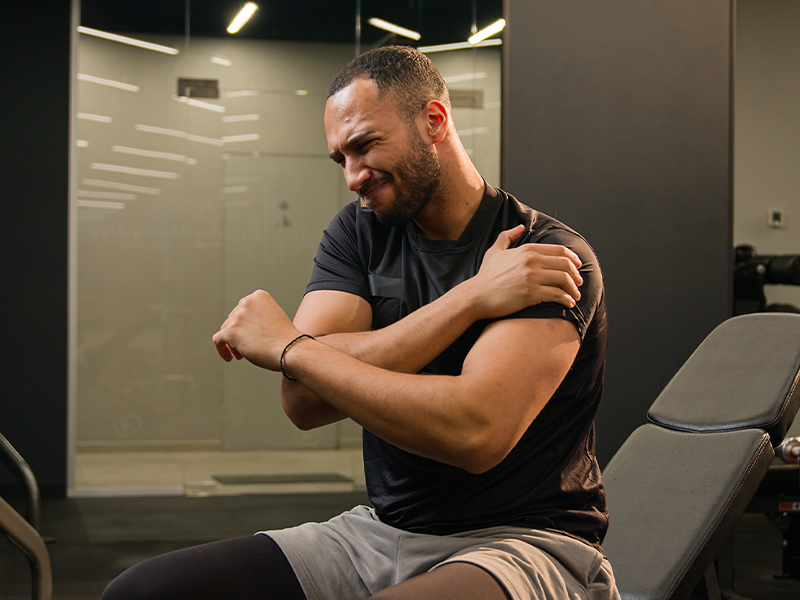Search
Find a Physician
Robert A. DeFalco, Jr., DO
Medically Reviewed by
William Sayde, MDBlog
Jun 11, 2025
It might start with a harmless fall or a bump to the shoulder—nothing that feels serious at first. Maybe some soreness, a bit of swelling, but nothing you can't push through. Then a few days pass, and things don’t get better. Reaching up hurts, carrying bags feels impossible, and sleeping on your side becomes a challenge. What seemed minor is now interfering with your daily life. AC joint injuries have a way of sneaking up like that—starting small, then turning into something far more painful and limiting than you expected.
The AC joint, short for acromioclavicular joint, is where the collarbone (clavicle) meets the highest point of your shoulder blade (called the acromion). It’s right at the very top of your shoulder and plays a key role in keeping your shoulder stable while you move your arm in different directions. Sometimes, this joint can get injured—either the joint itself or the ligaments that hold it in place can be damaged. This can happen from a sudden injury, like falling on your shoulder, or from repetitive strain over time. Many people also experience pain in this joint because of osteoarthritis, a condition where the cartilage that cushions the joint gradually wears down, causing discomfort and stiffness. Whether from injury or arthritis, problems with the AC joint can make everyday shoulder movements painful or difficult.
An AC joint injury can range from mild to seriously disruptive, depending on the severity. A mild sprain might just feel like soreness or a small bump near your shoulder, while a severe separation can cause intense pain, visible deformity, and loss of shoulder function.
The AC joint plays a key role in arm movement and shoulder stability, so any injury there can throw off your entire upper body mechanics. Also, sleeping, dressing, or lifting even light objects can become uncomfortable. While many cases heal with rest and rehab, more serious injuries might need surgery and a longer recovery.
A torn AC joint often feels like a sharp, stabbing pain right at the top of your shoulder, especially when you try to lift your arm or carry something heavy. The area might swell quickly, and the pain can radiate down into your upper arm. You may also notice a visible bump where the collarbone meets the shoulder, depending on the severity of the injury.
Less severe AC joint injuries can come with a dull ache or tenderness instead of intense pain. There may be mild swelling, but it’s easy to mistake the discomfort for a simple muscle strain. Some people feel stiffness or instability in the joint without any bruising or visible deformity. Others may only notice symptoms when they’re lifting, pushing, or reaching overhead.
Shoulder injuries can be easy to brush off at the moment, but symptoms like these are your body’s way of flagging deeper issues. Ignoring them often leads to slower recovery and more persistent problems.
In many cases, conservative treatment, like rest, ice, and physical therapy, can ease shoulder pain and help the joint heal naturally. These approaches are especially effective when the injury is mild and the joint remains stable. For many people, sticking to a treatment plan can gradually restore strength and mobility without the need for surgery. This happens in scenarios where:
However, there are situations where this approach just isn’t enough. If the damage is too severe or the joint is visibly out of place, no amount of rest will realign it properly. Persistent pain and poor shoulder function are clear signs that something more may be needed. For instance:
Surgery isn’t always the first step, but for more serious AC joint injuries, it can make all the difference in recovery and long-term shoulder stability.
Recovering from AC joint injuries without surgery usually involves patience and consistency. Most people start with rest and anti-inflammatory treatments to reduce swelling and pain. Once the pain eases up, physical therapy plays a big role in regaining range of motion, improving strength, and getting the shoulder to function normally again. If the injury is mild, many people are back to full activity within a few weeks to a couple of months.
When surgery is involved, recovery takes a bit more time and structure. After an AC joint reconstruction, you’ll likely spend the first few weeks in a sling to allow the repaired ligaments to heal. Gentle movement is reintroduced gradually, usually under the supervision of a physical therapist. Full recovery from this type of surgery can take four to six months, especially if the goal is to return to sports or heavy lifting.
If you’ve had a distal clavicle excision—where part of the collarbone is shaved down to relieve grinding arthritic pain—you may feel relief fairly quickly. However, the shoulder will still need time to adjust, and rebuilding strength becomes a priority. Most people begin gentle exercises within a few weeks and see major progress by the three-month mark. The timeline depends a lot on how active you were before and what your goals are after surgery.
In cases where hardware fixation was used—such as plates or screws—recovery can involve additional steps. These devices are meant to hold things in place while your body heals, which means you’ll need to follow a stricter plan early on. Some patients may need a second procedure to remove the hardware later. Still, once healing is complete, the outcomes are often very positive.
To speed up recovery and get the best results, consistency is everything. Sticking to your rehab plan, staying active within your limits, and doing targeted shoulder pain exercises all help you regain mobility and strength. Ice and anti-inflammatory medications can also keep swelling under control, especially in the early stages. Most importantly, listen to your body—pushing too hard too soon can set you back.
Recovering from an AC joint injury isn’t always straightforward, but the good news is that most people can get back to full strength with the right care and a little patience. Whether you’re dealing with a mild sprain or recovering from surgery, it’s all about listening to your body and staying consistent with your treatment plan. The shoulder is a complex joint, and regaining full motion takes time, but each step you take brings noticeable progress. The more disciplined you are about rehab, the quicker you’ll feel like yourself again.
AC joint injuries may start off feeling minor, but they can easily become more than just a nuisance if left untreated. That’s why early attention and a tailored recovery plan matter so much. From icing in the early days to rebuilding strength with physical therapy or surgery when necessary, there’s no one-size-fits-all fix. Still, with proper support and steady effort, most people make a strong comeback. Don’t rush it—but don’t ignore it either. Taking your recovery seriously means getting back to the things you love with less pain and greater confidence.
Experiencing shoulder discomfort? Learn how the Orthopedic Institute of NJ can help you identify, treat, and recover from AC joint injuries with confidence.
Robert A. DeFalco, Jr., DO


